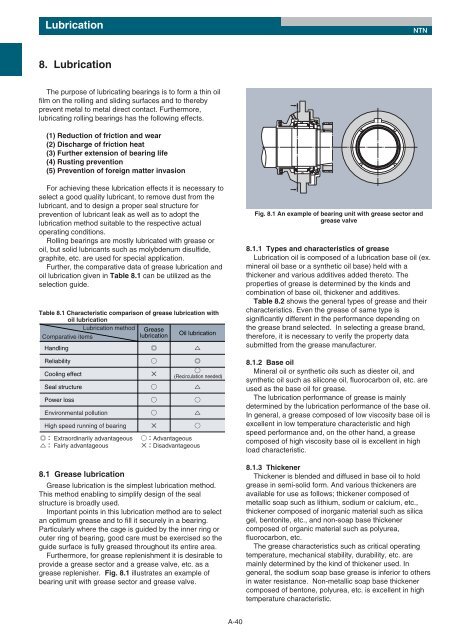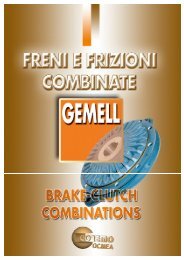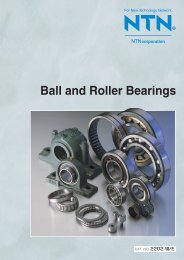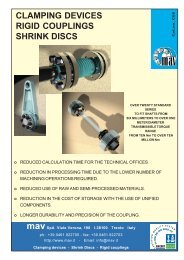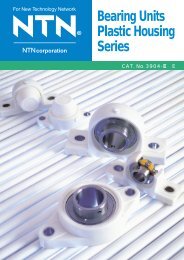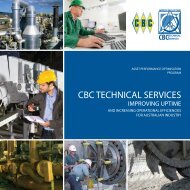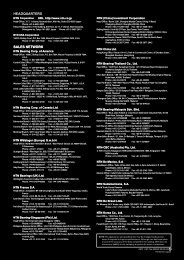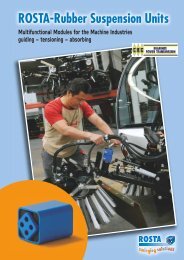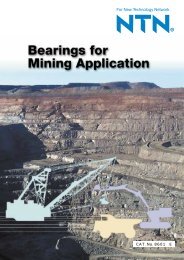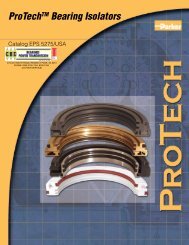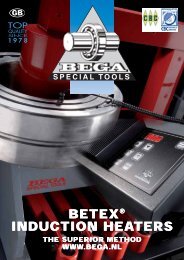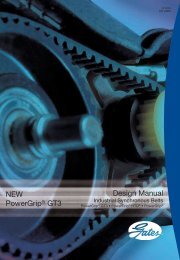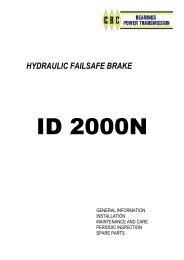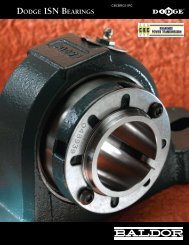Needle Roller Bearings - Ntn-snr.com
Needle Roller Bearings - Ntn-snr.com
Needle Roller Bearings - Ntn-snr.com
Create successful ePaper yourself
Turn your PDF publications into a flip-book with our unique Google optimized e-Paper software.
Lubrication<br />
NTN<br />
8. Lubrication<br />
The purpose of lubricating bearings is to form a thin oil<br />
film on the rolling and sliding surfaces and to thereby<br />
prevent metal to metal direct contact. Furthermore,<br />
lubricating rolling bearings has the following effects.<br />
(1) Reduction of friction and wear<br />
(2) Discharge of friction heat<br />
(3) Further extension of bearing life<br />
(4) Rusting prevention<br />
(5) Prevention of foreign matter invasion<br />
For achieving these lubrication effects it is necessary to<br />
select a good quality lubricant, to remove dust from the<br />
lubricant, and to design a proper seal structure for<br />
prevention of lubricant leak as well as to adopt the<br />
lubrication method suitable to the respective actual<br />
operating conditions.<br />
Rolling bearings are mostly lubricated with grease or<br />
oil, but solid lubricants such as molybdenum disulfide,<br />
graphite, etc. are used for special application.<br />
Further, the <strong>com</strong>parative data of grease lubrication and<br />
oil lubrication given in Table 8.1 can be utilized as the<br />
selection guide.<br />
Table 8.1 Characteristic <strong>com</strong>parison of grease lubrication with<br />
oil lubrication<br />
Lubrication method<br />
Comparative items<br />
Handling<br />
Grease<br />
lubrication<br />
<br />
Oil lubrication<br />
<br />
Fig. 8.1 An example of bearing unit with grease sector and<br />
grease valve<br />
8.1.1 Types and characteristics of grease<br />
Lubrication oil is <strong>com</strong>posed of a lubrication base oil (ex.<br />
mineral oil base or a synthetic oil base) held with a<br />
thickener and various additives added thereto. The<br />
properties of grease is determined by the kinds and<br />
<strong>com</strong>bination of base oil, thickener and additives.<br />
Table 8.2 shows the general types of grease and their<br />
characteristics. Even the grease of same type is<br />
significantly different in the performance depending on<br />
the grease brand selected. In selecting a grease brand,<br />
therefore, it is necessary to verify the property data<br />
submitted from the grease manufacturer.<br />
Reliability<br />
Cooling effect<br />
Seal structure<br />
Power loss<br />
Environmental pollution<br />
High speed running of bearing<br />
Extraordinarily advantageous<br />
Fairly advantageous<br />
<br />
<br />
<br />
(Recirculation needed)<br />
<br />
<br />
<br />
<br />
<br />
<br />
<br />
<br />
Advantageous<br />
Disadvantageous<br />
8.1.2 Base oil<br />
Mineral oil or synthetic oils such as diester oil, and<br />
synthetic oil such as silicone oil, fluorocarbon oil, etc. are<br />
used as the base oil for grease.<br />
The lubrication performance of grease is mainly<br />
determined by the lubrication performance of the base oil.<br />
In general, a grease <strong>com</strong>posed of low viscosity base oil is<br />
excellent in low temperature characteristic and high<br />
speed performance and, on the other hand, a grease<br />
<strong>com</strong>posed of high viscosity base oil is excellent in high<br />
load characteristic.<br />
8.1 Grease lubrication<br />
Grease lubrication is the simplest lubrication method.<br />
This method enabling to simplify design of the seal<br />
structure is broadly used.<br />
Important points in this lubrication method are to select<br />
an optimum grease and to fill it securely in a bearing.<br />
Particularly where the cage is guided by the inner ring or<br />
outer ring of bearing, good care must be exercised so the<br />
guide surface is fully greased throughout its entire area.<br />
Furthermore, for grease replenishment it is desirable to<br />
provide a grease sector and a grease valve, etc. as a<br />
grease replenisher. Fig. 8.1 illustrates an example of<br />
bearing unit with grease sector and grease valve.<br />
8.1.3 Thickener<br />
Thickener is blended and diffused in base oil to hold<br />
grease in semi-solid form. And various thickeners are<br />
available for use as follows; thickener <strong>com</strong>posed of<br />
metallic soap such as lithium, sodium or calcium, etc.,<br />
thickener <strong>com</strong>posed of inorganic material such as silica<br />
gel, bentonite, etc., and non-soap base thickener<br />
<strong>com</strong>posed of organic material such as polyurea,<br />
fluorocarbon, etc.<br />
The grease characteristics such as critical operating<br />
temperature, mechanical stability, durability, etc. are<br />
mainly determined by the kind of thickener used. In<br />
general, the sodium soap base grease is inferior to others<br />
in water resistance. Non-metallic soap base thickener<br />
<strong>com</strong>posed of bentone, polyurea, etc. is excellent in high<br />
temperature characteristic.<br />
A-40


